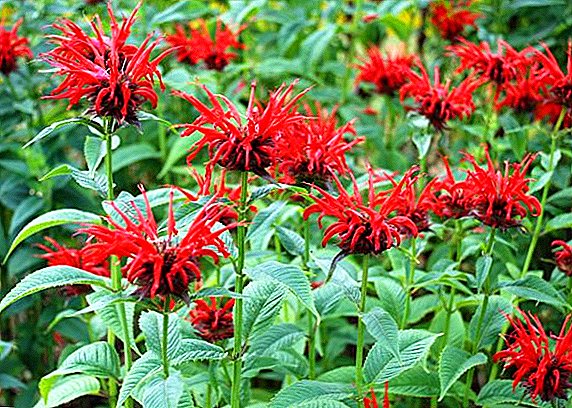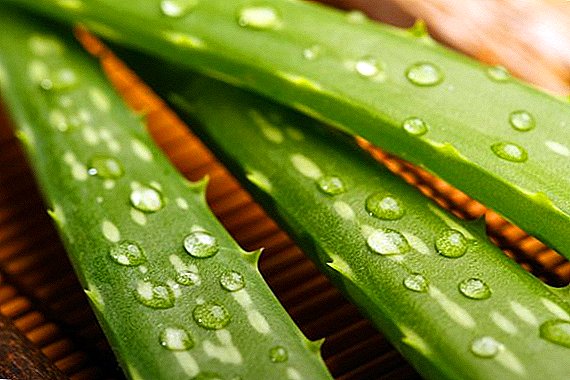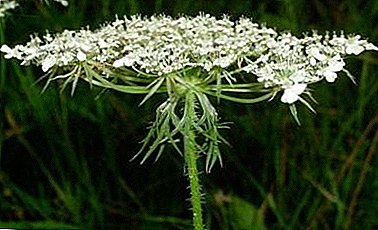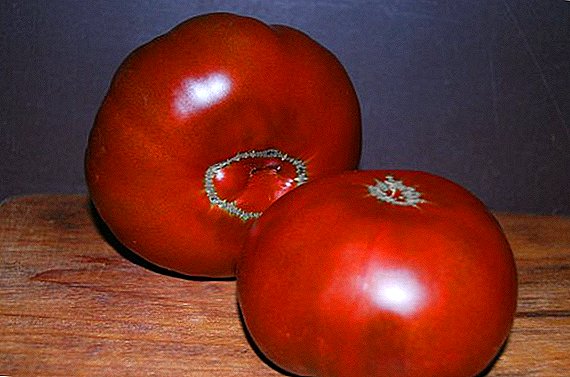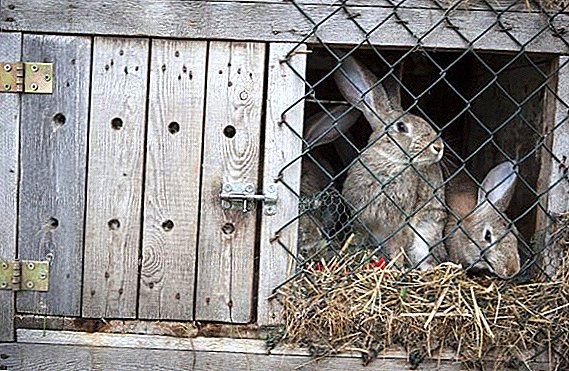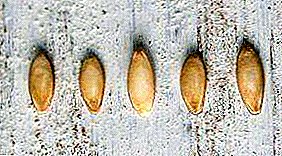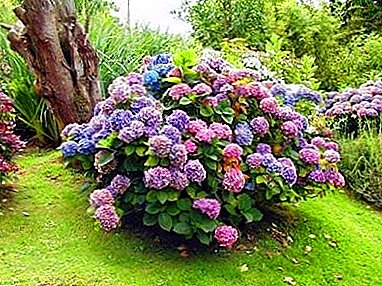
Garden hydrangea - the favorite of many gardeners. Attractive air caps of lush inflorescences of white, blue, pink, lime shade add refinement to any landscape.
To successfully plant and grow hydrangea in your garden, you need to follow a few simple guidelines.
The name "hydrangea" flower received in honor of the princess of the Holy Roman Empire. And the Latin name of the family Hydrangea (Hydrangia) means in translation from the Greek "vessel with water." According to one version, this reflects a special hydrangea hydrangeaon the other - the shape of seed boxes, resembling a jug.
A photo





When to plant?
The optimal time for planting garden hydrangea - Spring, after the threat of nocturnal freezing of the soil has passed, but before the buds began to bloom.
In regions with not very severe winter permissible autumn planting, but here you need to catch up to the first frost.
Cuttings recommended to plant only in the spring, to give them the opportunity for the active season to take root and gain strength before the next wintering.
Choosing the best place
Hortensia tolerates some shading well, grows well in penumbra. Like any aristocrat, she does not tolerate exposure to direct sunlight. Choose a slightly shaded spot, most brightly lit in the morning.
 Keep in mind that an adult bush, taking into account branches and flowers, takes about 1.5 m in diameter.
Keep in mind that an adult bush, taking into account branches and flowers, takes about 1.5 m in diameter.
The soil for hydrangea should be loose, nutritious composition, with predominantly acidic medium. Alkaline environment is strictly not suitable for hydrangeas - they lime is contraindicated.
The ideal option is mature compostcontaining many nutrients.
Bad and good neighbors
Not worth it place the hydrangea next to the plants with a shallow root system, since, due to similar environmental requirements, they will oppress each other. Do not plant hydrangea under the trees - the powerful roots of the trees take away all the moisture from the soil.
Best neighborhood for hydrangeas, these are plants with fleshy roots or tubers. Very well adjacent to the hosts, astilba, looks beautiful in combination with boxwood.
After the purchase
If you purchased a new pet in the store, most likely, it is grown in a greenhouse and therefore somewhat pampered. You need to teach your princess to a new place of residence. For this when landing remember:
- if you are not going to plant hydrangea immediately after purchase, then water it abundantly before planting;
- in no case can neither shorten nor prune the roots of the plant taken out of the container (although it is often recommended!);
- they also can not be soaked and shake off the ground;
- the roots of the plant should not feel a sharp transition from the store substrate to the garden soil, otherwise the growth of the root system will slow down or stop. In the pit for planting, mix the garden soil with fertilized at least 25 cm from the plant.
 After landing a greenhouse capricious, accustomed to drip irrigation and large doses of phytohormones and fertilizers, will have to adapt. You have to gradually "remove" the plant from a stimulating diet, as a patient with strong painkillers. To do this, the first two months after planting 1 time in two weeks, be sure to feed the plant mineral and organic fertilizers.
After landing a greenhouse capricious, accustomed to drip irrigation and large doses of phytohormones and fertilizers, will have to adapt. You have to gradually "remove" the plant from a stimulating diet, as a patient with strong painkillers. To do this, the first two months after planting 1 time in two weeks, be sure to feed the plant mineral and organic fertilizers.
If you have planted a young plant, grown from a rooted cutting, in the first year don't let him bloom, tear off the resulting inflorescence, to give the opportunity to lay a full-fledged flower buds for next year.
Care during the season
Watering. Remember that the hydrangea is a "vessel with water": ensure the possibility of abundant irrigation, ideally - drip. In a week, under each plant should fall several buckets of water, in any case not tap - only rain or separated. To prevent the soil from drying out, mulch the tree trunk with peat, needles, sawdust and bark, spreading the mulch in a layer of 20-25 cm.
 Crop. Throughout the summer, remove the inflorescences that have faded and dried - this will give the plant the opportunity to extend the flowering period. Rejuvenating pruning spend in the spring - remove shoots, which froze after severe cold weather, as well as branches that are more than three years old. After the buds awaken, correct the result - cut the shoots with unblown buds. In order to bush was lush, cut off the shoots on 4-5 bud.
Crop. Throughout the summer, remove the inflorescences that have faded and dried - this will give the plant the opportunity to extend the flowering period. Rejuvenating pruning spend in the spring - remove shoots, which froze after severe cold weather, as well as branches that are more than three years old. After the buds awaken, correct the result - cut the shoots with unblown buds. In order to bush was lush, cut off the shoots on 4-5 bud.
If you want to rejuvenate the old hydrangea bush, in the fall, completely cut off all the shoots under the root, leaving only a small stump. In the spring of a powerful root system allows you to quickly grow a lush crown.
Top dressing. Two or three times a month water it with organic fertilizer dissolved in it (humus, manure). Do not overdo it with mineral fertilizers, their excess can badly affect the winter hardiness of the plant. Ash cannot be fertilized.
When to transplant?
If you want to transplant hydrangea, follow the same rules and recommendations as when you first plant the plant. It is best to do this in early spring or autumn after the end of the flowering period.
If your goal is not just a change of place for a beautiful bush, but a reproduction of hydrangea, then the best technology will be the following:
- Liberally water the plant and let the moisture soak.
- Dig in a circle at a distance of 15 cm from the bush. It is more efficient to use forks.
- Tilt the bush and use a sharp knife or shovel to separate part of it.
- Disinfect the incision site with ash.
- Replant part of the bush in a prepared pit in a new place.
Take care of Princess Hortensia during planting, and this magnificent plant will thank you for taking care of its spectacular appearance, becoming the real pearl of your beautiful garden.
Useful information
You can get acquainted with other materials about hydrangea garden:
- How to properly care for panicles bobo? Growing and preparing for winter
- How to properly care for Limelight?
- How does the Duboliferous hydrangea overwinter?
- Frost-resistant Pinky Winky on your site
- Hortensia paniculata grandiflora - features of care and reproduction in the garden plot
- Hydrangea curly (petiolate, climbing) - a hedge in your garden!
- Hydrangea tree Annabelle - snow-white decoration of your site
- Tree hydrangea in your garden - planting and care, breeding, wintering
- How to make friends with serrated hydrangea?
- Japanese hydrangea Kyushu in your garden
- Frost-resistant large leaves
- How to care for paniculate phantom? Planting, wintering, breeding
- How to properly care for panicle vanilla fraze?
- Fragrant "princess" hydrangea paniculata in your garden: features of care
- Secrets of breeding garden hydrangea
- Do not let her freeze! How to cover the hydrangea for the winter?
- How to protect against diseases and pests?


